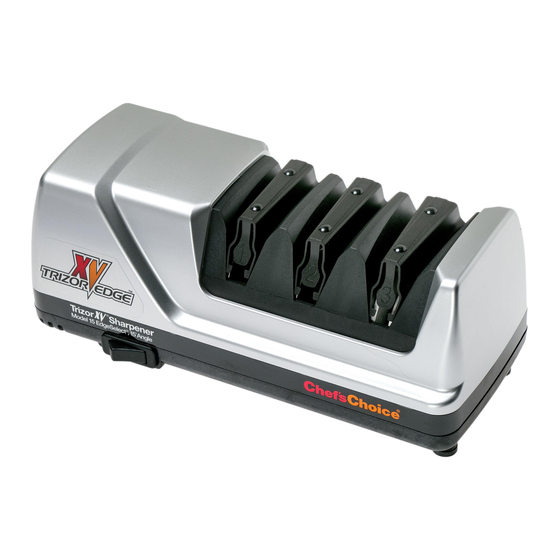Summary of Contents for Chef's Choice Trizor XV
- Page 1 INSTRUCTIONS MODEL 15 ™ Trizor XV Knife Sharpener ® EdgeSelect —15° Edge ngle Read these instructions before use. It is essential that you follow these instructions to achieve optimum results. © 2010 EdgeCraft Corp.
-
Page 2: Important Safeguards
14.Close supervision is necessary when any appliance is used by or near children or the infirm. 15. Do not use honing oils, water or any other lubricant with the Trizor XV™ Model 15. 16. For household use only. 17. SAVE THESE INSTRUCTIONS. - Page 3 Asian knives. Asian artisans devoted lifetimes to develop the skills required to hand sharpen edges of this quality. Now you can with the Trizor XV™ Sharpener sharpen, hone and strop to the same perfection in a matter of seconds.
- Page 4 You will find it easy to convert any of your household knives to the new Trizor XV™, 15 degree edge. It is very likely that all of your conventional kitchen knives whether European or American brands have been sharpened through the years at about 20 degrees.
- Page 5 If you have European or American brand knives, it is extremely easy to convert their edge to the Trizor XV™ (15 degree) edge. The procedure outlined here applies equally to sharpening contemporary Asian blades. The edge of Euro/American and contemporary Asian knives are identical in that they are sharpened on both sides of the edge.
- Page 6 To convert from the existing Euro/American edge to the Trizor XV™ edge or to sharpen contemporary Asian blades, start with the Sharpening Stage 1 as follows: EURO/AMERICAN AND CONTEMPORARY ASIAN BLADES START IN SHARPENING STAGE 1 Turn ON the power and pull the length of blade thru the left slot (Figure 4) and then thru the right slot of Stage 1, using the left and right slots on alternate pulls.
- Page 7 STROPPING/POLISHING THE EDGE IN STAGE 3 Pull the blade through the left slot of Stage 3 (see Figure 7) and then through the right slot of Stage 3. Make 3 pairs of pulls, alternating each pull in the left and right slots. You should take about 3 to 4 seconds for each pull for a 5 inch (12 cm) long blade.
- Page 8 traditional Japanese knives and the detailed structure of the cutting edges likewise vary widely from one manufacturer to the next, however there are some similarities. The cutting edge consists of a small primary facet on the front face of the blade below the large bevel and a much smaller secondary microfacet along the back face.
- Page 9 easily felt as shown in Figure 5. Make certain the burr is present along the entire length of the edge. If there is no burr or only a partial burr, continue to make additional pulls all in the left slot about five (5) at a time and check for a burr after each group of five (5) pulls.
- Page 10 DESCRIPTION OF EURO/AMERICAN AND ASIAN BLADES In general you will find that Euro/American blades shown in Figure 10a are sturdier than the more delicate and thinner contemporary Asian blades. The variation among com- mercially available knives of any type is great and in fact some Euro/American blades are very thin and certain Asian knives have a thicker cross-section designed for heavier work.
- Page 11 about 15º is created along the front of the edge of the sashimi blade as shown in Figures 10c and 10d in order to establish the geometry of the cutting edge. An even smaller cutting micro- Back facet (barely visible to the unaided eye) is customarily created Factory on the back face of the blade to enhance the sharpness of the Bevel A...
- Page 12 When resharpening the Gourmet edge use Stage 3 each time (alternating left and right slots). If after a number of resharpenings, it is taking too long to resharpen, you can speed the process by resharpening first in Stage 2 following the procedures detailed, and then resharpen in Stage 3.
- Page 13 ® Serrated blades of all types can be sharpened in the Chef’sChoice Model 15. However, use only Stage 3 (Figure 12) which will sharpen the teeth of the serrations and develop microblades along the edge of these teeth. Generally five (5) to ten (10) pairs of alternat- ing pulls in Stage 3 will be adequate.
- Page 14 SUGGESTIONS 1. Always clean all food, fat and foreign materials from the blade surfaces before sharp- ening or resharpening. If badly soiled, use detergent and water to clean. 2. Some contemporary Asian knives and Granton type blades are dimpled and some contemporary and traditional Asian blades are made of layered Damascus steel.
- Page 15 without using this technique, it is the best and fastest way to determine when you have sharpened sufficiently in the preliminary steps. This will help you avoid oversharpening and ensure incredibly sharp edges every time. Cutting a tomato or a piece of paper is a convenient method of checking for finished blade sharpness.
- Page 16 825 Southwood Road Avondale, PA 19311 Customer Service (800) 342-3255 or (610) 268-0500 ® Assembled in USA www.chefschoice.com This product may be covered by one or more EdgeCraft patents and/or patents pending as ® ® ® marked on the product. Chef’sChoice...


















Need help?
Do you have a question about the Trizor XV and is the answer not in the manual?
Questions and answers